
Corinth is the successor to an ancient city, and is a former municipality in Corinthia, Peloponnese, which is located in south-central Greece. Since the 2011 local government reform, it has been part of the municipality of Corinth, of which it is the seat and a municipal unit. It is the capital of Corinthia.

The history of Panama includes the long history of the Isthmus of Panama region prior to European colonization, from Pre-Columbian cultures, through the Spanish colonial era, and eventual independence as the modern country of Panama.

An isthmus is a narrow piece of land connecting two larger areas across an expanse of water by which they are otherwise separated. A tombolo is an isthmus that consists of a spit or bar, and a strait is the sea counterpart of an isthmus.
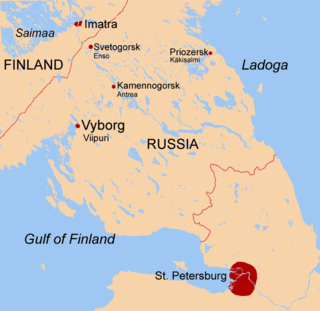
The Karelian Isthmus is the approximately 45–110 km(30–70 mi) wide stretch of land, situated between the Gulf of Finland and Lake Ladoga in northwestern Russia, to the north of the River Neva. Its northwestern boundary is a line from the Bay of Vyborg to the westernmost point of Lake Ladoga, Pekonlahti. If the Karelian Isthmus is defined as the entire territory of present-day Saint Petersburg and Leningrad Oblast to the north of the Neva and also a tiny part of the Republic of Karelia, the isthmus' area covers about 15,000 km2(6,000 sq mi).
Karelia, the land of the Karelian people, is an area in Northern Europe of historical significance for Russia, the USSR, Finland and Sweden. It is currently divided among the northwestern Russian Federation and Finland.

The Isthmus of Corinth is the narrow land bridge which connects the Peloponnese peninsula with the rest of the mainland of Greece, near the city of Corinth. The word "isthmus" comes from the Ancient Greek word for "neck" and refers to the narrowness of the land. The Isthmus was known in the ancient world as the landmark separating the Peloponnese from mainland Greece. In the first century AD the geographer Strabo noted a stele on the Isthmus of Corinth, which bore two inscriptions. One towards the East, i.e. towards Megara, reading: "Here is not Peloponnesus, but Ionia" and the one towards the West, i.e. towards the Peloponnese: "Here is Peloponnesus, not Ionia" ; Plutarch ascribed the erection of the stele to the Attic hero Theseus, on his way to Athens.

The Isthmus of Tehuantepec is an isthmus in Mexico. It represents the shortest distance between the Gulf of Mexico and the Pacific Ocean. Prior to the opening of the Panama Canal, it was a major overland shipping route known simply as the Tehuantepec Route. The name is taken from the town of Santo Domingo Tehuantepec in the state of Oaxaca; this was derived from the Nahuatl term Tēcuāntepēc.

Tehuantepec is a city and municipality in the southeast of the Mexican state of Oaxaca. It is part of the Tehuantepec District in the west of the Istmo Region. The area was important in pre Hispanic period as part of a trade route that connected Central America with what is now the center of Mexico. Later it became a secondary capital of the Zapotec dominion, before it was conquered by the Spanish in the early 16th century.
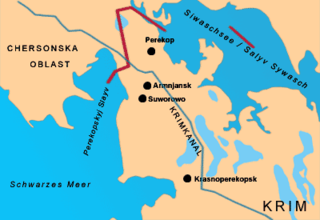
The Isthmus of Perekop is the narrow, 5–7 kilometres (3.1–4.3 mi) wide strip of land that connects the Crimean Peninsula to the mainland of Ukraine. The isthmus projects between the Black Sea to the west and the Sivash to the east. The isthmus takes its name of "Perekop" from the Tatar fortress of Or Qapi.

Auckland City was a city in the Auckland urban area, covering the central isthmus and most of the islands of the Hauraki Gulf. It included the Auckland CBD – a major financial and commercial centre – and a number of suburbs.

The Halifax Peninsula is a community and planning area located in the urban core of municipal Halifax, Nova Scotia. Halifax Peninsula is home to Downtown Halifax, the financial and economic heart of the municipality, which was also the site of the original settlement and town of Halifax. The town of Halifax was founded by the British government under the direction of the Board of Trade and Plantations under the command of Governor Edward Cornwallis in 1749. Geographically, the Halifax Peninsula is a Canadian peninsula in central Nova Scotia.

The Isthmus of Panama, also historically known as the Isthmus of Darien, is the narrow strip of land that lies between the Caribbean Sea and the Pacific Ocean, linking North and South America. It contains the country of Panama and the Panama Canal. Like many isthmuses, it is a location of great strategic value.
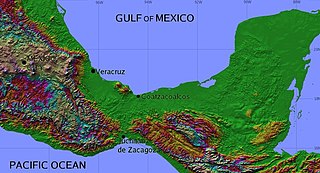
Juchitán de Zaragoza is an indigenous town in the southeast of the Mexican state of Oaxaca. It is part of the Juchitán District in the west of the Istmo de Tehuantepec region. With a 2005 census population of 74,714 inhabitants, it is the fourth-largest city in the state. The majority of the indigenous inhabitants are Zapotecs and Huaves. The town also serves as the municipal seat for the surrounding municipality, with which it shares a name. The municipality has an area of 414.64 km² and a population of 85,869, the state's third-largest in population.

Two Harbors, colloquially known as "The Isthmus", is a small unincorporated community island village on the island of Santa Catalina Island, California, with a population of 298. It is the second center of population on the island, besides the city of Avalon. It is mainly a resort village. It has only one restaurant, one hotel and one general store. The village has about 150 permanent residents who live on the isthmus year-round. One notable feature was the one-room schoolhouse which closed in 2014.
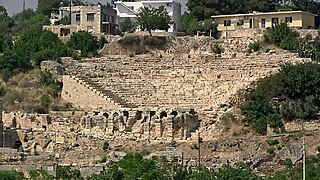
Elaiussa Sebaste or Elaeousa Sebaste was an ancient Roman town located 55 km (34 mi) from Mersin in the direction of Silifke in Cilicia on the southern coast of Anatolia.
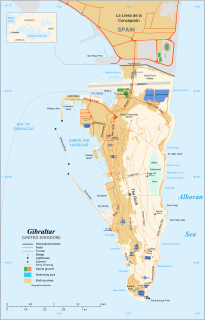
The Gibraltar territory currently contains an 800-metre (2,625 ft) long section of the isthmus that links the Rock with mainland Spain. Spain does not acknowledge British sovereignty over Gibraltar beyond the fortified perimeter of the town as at 1704. The United Kingdom claims the southern part of the isthmus on the basis of continuous possession over a long period.

The Madison Isthmus is an isthmus in Madison, Wisconsin, between Lake Mendota and Lake Monona. It is located between Madison's northeast side to the east and the University of Wisconsin campus to the west.

The Battle of Cartagena 209 BC was a successful Roman assault on the Carthaginian stronghold New Carthage (Cartagena) in Iberia that took place in late January to early February of 209 BC.

Isthmus is a free alternative weekly newspaper based in Madison, Wisconsin (US). Founded by Vince O'Hern and Fred Milverstedt in 1976, the paper is published on Thursdays, and has a weekly circulation of 50,000. The newspaper offers local news, opinion, sports and the arts, dining and music scenes.
Isthmus Mixe, called Lowland Mixe in Wichmann (1995), is a Mixe language spoken in Mexico. It is spoken in the villages of Coatlán San José el Paraíso, Mazatlán, Guichicovi, and Camotlán, Oaxaca.
















